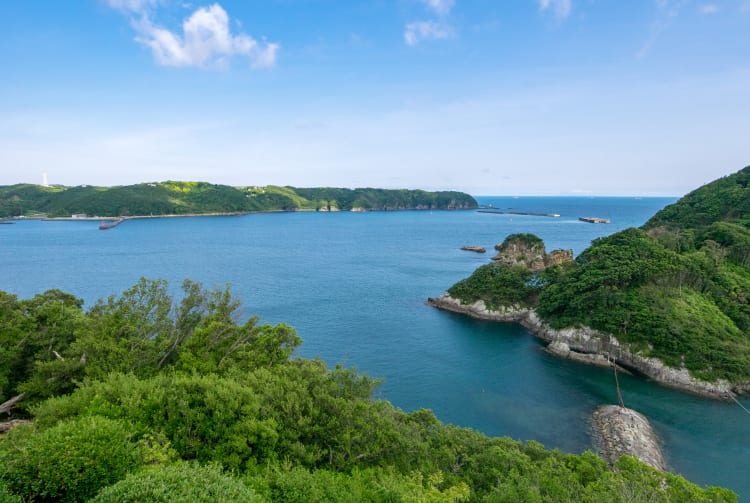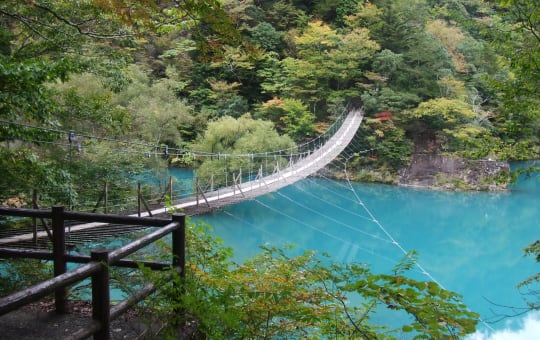El primer enclave occidental de la era moderna en Japón es hoy un paraíso de sol, surf y arena
Shimoda es una ciudad turística del extremo sureste de la península de Izu . A pesar de la naturaleza tranquila de esta localidad costera, en 1858 el diplomático estadounidense Townsend Harris negoció en ella un tratado comercial que ponía fin al aislamiento autoimpuesto de Japón durante siglos con Occidente y se abría al comercio, lo que provocó el final del domino samurái.
Hoy la gente visita Shimoda en busca de sol y diversión. Muchos vienen a surfear las olas de las extensas playas de Shirahama , Kisami Ohama e Iritahama, así como de las calas más apartadas, como la de Tatadohama. Aquí la arena es suave, blanca e increíblemente limpia, y los surfistas encuentran desde olas que rompen suavemente hasta grandes oleajes. Shimoda además es un destino ideal para disfrutar de una escapada en familia.
Los buzos más experimentados no pueden perderse la isla de Mikimoto, cercana a Shimoda, donde encontrarán coloridos arrecifes de coral y grandes criaturas marinas, como tiburones, atunes y rayas.
No te pierdas
- Las playas de arena blanca y el surf en Shirahama
- Explorar las animadas opciones de ocio nocturno en la calle Perry
- Nadar entre delfines en el Acuario Flotante de Shimoda
Cómo llegar
A Shimoda se puede acceder en tren y en coche. Desde Tokio, las mejores opciones son el tren bala Tokaido y los trenes regulares de las líneas JR.
Shimoda tiene conexión directa con Tokio mediante la línea de trenes rápidos limitados Odoriko de JR. También se puede tomar el tren bala Tokaido hasta la estación de Atami y hacer transbordo a un tren rápido limitado Odoriko o a un tren local de la línea privada Izukyu. Bájate en la estación de Izukyu-Shimoda, la terminal de los ferrocarriles Izukyu.
Datos breves
Hay excursiones turísticas en barco negro por el puerto
En el templo Ryosenji, en la inmediaciones, hay objetos que pertenecieron al comodoro Perry
Aquí terminó el largo aislamiento de Japón del mundo exterior
Disfruta de vistas aéreas
Con el teleférico de Shimoda se puede subir hasta la cumbre del monte Nesugata, con diversos miradores con vistas aéreas de la ciudad, el cabo Suzaki y el Pacífico.
Contempla de cerca la vida marina y disfruta de un baño termal
El Acuario Flotante de Shimoda reposa en la bahía de Wakanoura, al sur del teleférico, y acoge más de 200 especies de peces. También ofrece la oportunidad de tocar los delfines e incluso montar en kayak o bucear junto a estos animales. El extenso parque de Shimoda está frente al acuario y cuenta con exuberantes senderos que circundan la bahía.
Aunque el acuario y el parque son lugares bonitos y dignos de explorar, la mayoría de los visitantes se acercan a Shimoda atraídos por sus playas de arena blanca y bahías de aguas cristalinas. Para muchos amantes de los deportes, este lugar del extremo peninsular es aún más notorio. La bahía protegida roza las aguas abiertas del océano Pacífico. Esto atrae a gran variedad de peces y corrientes que serán la devoción de aficionados a la pesca, navegantes, surfistas y buceadores.
La vida en la calle del comodoro
La calle Perry debe su nombre al comodoro Perry, al mando de los Barcos Negros que obligaron a Japón a abrir sus puertas, y es uno de los principales centros de ocio nocturno de la ciudad de Shimoda. La gran oferta deportiva, el encanto de las playas y el carácter internacional y desenfadado de Shimoda han convertido la ciudad en un imán para los jóvenes de cuerpo y alma. Multitud de «residentes» de Shimoda viven y trabajan en Tokio o Yokohama entre semana y vuelven a la isla para disfrutar del fin de semana.
Como resultado de esta subcultura, han emergido infinidad de restaurantes, bares, tiendas y cafeterías tanto en la calle Perry como en la zona del puerto. Esta calle conduce hasta Ryosenji , el templo donde Perry y las autoridades del shogunato de Tokugawa firmaron el acuerdo.
Se trata de un pequeño templo budista relativamente insulso si lo comparamos con la magnificencia de muchos otros del país. Sin embargo, por tratarse del lugar donde se firmó el Tratado de Shimoda, el gobierno de Japón ha declarado la zona y el salón principal como Lugares de Importancia Histórica Nacional. En el interior hay un pequeño museo con una exposición de objetos relacionados con el Comodoro Perry, los Barcos Negros y los contactos entre Japón y Occidente.


Un paraíso onsen con evocadores baños interiores y rotenburo al aire libre
Shimokamo Onsen, en Minami-Izu, es un pueblo termal con baños tonificantes disponibles en las diferentes pensiones, entre las que destacan Hana no Omotenashi Nanraku y sus 25 baños. Estas aguas saladas son beneficiosas para tratar problemas cutáneos e intestinales.
Además de los baños de interior y al aire libre, a finales de invierno y principios de primavera podrás caminar por la orilla del río Aono para contemplar la belleza de las flores. El exuberante jardín tropical añade suntuosidad. Desde la estación de Shimoda salen autobuses hasta esta zona en un trayecto de unos 15 minutos.
Explorar la ciudad
Para descubrir Shimoda y sus alrededores, lo ideal y esencial es viajar en coche. Si no vas en coche, tendrás que andar mucho, recorrer grandes distancias en bici, gastarte un pequeño dineral en taxis o perder algo de tiempo esperando autobuses. Shimoda no cuenta con una gran red de transporte. Si viajas con equipaje adicional, como los surfistas, los buceadores o los bañistas, esto puede resultar un auténtico inconveniente.
En la zona encontrarás varias oficinas de alquiler de coches. Ten en cuenta que, en temporada alta de verano y durante los principales períodos vacacionales, como Año Nuevo, la Semana Dorada o el Obon, la disponibilidad de coches de alquiler es muy limitada. Lo mejor es que lo alquiles en Yokohama, Tokio o en una de las estaciones principales de camino a Shimoda.
Viajar en coche es crucial si quieres alojarte en Shimoda para explorar la península de Izu . Izu es la meca de los amantes de los onsen, los senderistas, los ciclistas, los pescadores, los navegantes, los surfistas, los nadadores y los amantes de la playa.














































